During the Land8x8 Lightning Talks in Seattle, Laura Rose, Principal at the landscape architecture and planning firm Walker Macy, contemplated the role of beauty in design.
At a time when landscape architects are leading the discourse on mitigating climate change, fostering community, and enacting social change, it is peculiar for Rose to center her discussion on beauty. While the art of design is still very central to what we do, the work of landscape architects has evolved beyond the romantic ideals of landscape being solely something to look at. Yet, after listening to her presentation, it becomes clear that the term “beauty” describes much more than just aesthetic appeal or artistic whimsy.
The Merriam-Webster dictionary defines beauty as “the quality or aggregate of qualities in a person or thing that gives pleasure to the senses or pleasurably exalts the mind or spirit”. Using this definition, the role of beauty extends beyond appearance and into experiences. Rose asserts that “beauty is about experience and comfort – an attitude that places and people are worth caring for.” Beautiful, well-maintained spaces make people feel important, welcomed, and cherished. A beautiful landscape can address many of the critical issues that impact people’s lives and the environment. In addition to enhancing the lives of individuals, these spaces also strengthen communities, giving a sense of ownership to the community.
To drive her point, Rose shared a few examples from her recent work at Walker Macy.
At Eagle Harbor Waterfront Park, located in Bainbridge Island, WA, Rose and her team were tasked with the re-design of an existing sloping open space adjacent to the waterfront. The team could have proposed a simple path of switchbacks traversing the sloped landscape, but instead saw the opportunity to transform the existing passive park into an experiential corridor connecting residents to the water’s edge. This small decision had large impacts, enabling the design team the ability to create a new public amenity – with sculpted pathways, a rich planting palette and clearly defined gathering spaces with views to the water – out of a space that was previously seen as a pass-through space. By extending the park’s programming beyond the bare minimum circulation required, the team created a beautiful space that provides visitors with a sense of tranquility.

Photo: Forest Park | Walker Macy
Working with the Portland Parks and Recreation Department, Rose and her team created a Visitors Center for Forest Park, one of the largest urban forests in the country. The project site is heavily disturbed, nestled at the base of a hill and located adjacent to an industrial site. The design team used this location to their advantage, and designed the Visitor’s Center as a laboratory where visitors can experience the forest in a state of transformation. They saw the beauty in this process and used design to share the story of the land, which is being nurtured back to life after years of disruption.
The last project that Rose shared was a waterfront redevelopment in Seattle along Portage Bay. Located in close proximity to University of Washington, the designers considered the needs of their user base and proposed a park with both active recreation and passive moments that allowed for plenty of opportunities to unwind. Further enhancing the sense of place, the design provides both experiential and visual connections to the water and creates a space that encourages both emotional and physical calm. As visitors meander along the path, tactile reminders of the water, such as boardwalk paving and breezy meadow plantings, surround them. The use of these natural materials are not only beautiful visually, but also provide uses with an opportunity to reflect, unplug, and feel closer to nature.
A beautiful space can improve human health and quality of life, providing visitors with the opportunity to relax, connect, and feel valued. So, as we work to tackle ambitious project goals, let’s not forget to perfect the modest ones: creating beautiful places that bring people together.
—
This video was filmed on June 7, 2018 in Seattle, WA as part of the Land8x8 Lighting Talks sponsored by Anova Furnishings.




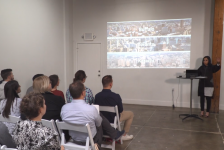

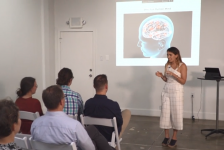
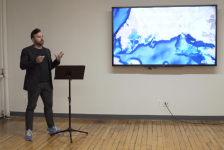
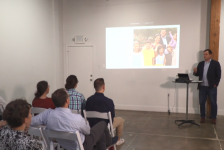
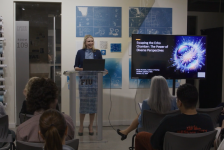
![10 Billion Mouths [Video]](https://land8.com/wp-content/uploads/2018/06/michael-grove-land8x8-224x150.png)

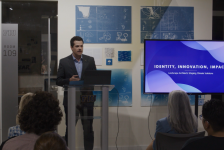
Mark Di Lucido
When I saw ‘Beauty’ in this post’s title, I immediately wondered if David Brooks would be referenced and sure enough, there he is! Mr. Brooks is, of course, the compassionate conservative commentator on the PBS NewsHour and other media outlets as well as an Op-Ed columnist for the New York Times. He occasionally writes about culture. Several years ago, he wrote a column entitled, “When Beauty Strikes”, for the Times. In this column, he quotes Leon Wieseltier, who in a Times Book Review stated, “We live in a post-humanist moment”. Brooks argues that in this ‘moment’ we are “beauty poor and meaning-deprived”. The post-humanist moment is perhaps better understood as the worldview we currently hold which Brooks considers to be the opposite of one based on beauty. Beauty, according to Brooks is, “… a big transformational thing, the proper goal of art and maybe civilization itself”. To say this another way, our current worldview is to make money, buy lots of stuff, live unsustainably, rely on technology for happiness, and occasionally include beauty in our lives as an afterthought.
Maybe if we embraced humanism a little more, we wouldn’t have to, “lead the discourse on mitigating climate change, fostering community, and enacting social change”.